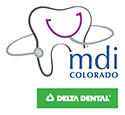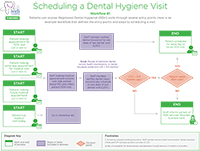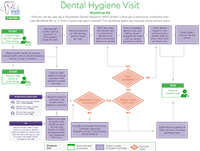
Creating Workflows
Developing workflows is important to establish a process for care delivery. A good workflow increases efficiency, helps staff understand their roles, and reduces miscommunication and waste.
Developing a workflow that integrates your dental hygienist is very similar to workflows that integrate other team members such as a behavioral health specialist, social worker, or health educator. Each practice’s workflow is unique. However, there are some guidelines that apply in most settings. You want to optimize the skills of your hygienist and minimize having him/her be responsible for workflow steps that can be done by others. It is important to utilize existing medical care team support staff in your CO MDI workflow.
In developing your CO MDI workflow, consider:
- Measuring your patients’ dental needs to estimate how much you need your hygienist (supply and demand).
- Managing your hygienist’s patient panel size and scope of practice.
- Optimizing the work of your care team.
- Anticipating your patients’ dental needs at the visit (this impacts the length of the visit).
- Creating backup plans for when your hygienist isn't available.
- Keeping things simple and distributing workflow tasks across the team.
| Developing Dental Hygiene Workflows in the Medical Setting | |
|---|---|
| Type of Dental Hygiene Visit | |
| Scheduled Dental Hygiene Visits | Open Dental Hygiene Visits |
| Scheduled visits allow the hygienist to be booked in advance. These visits could be used for new patients or patients who have previously seen the hygienist and are back for a recall visit. Scheduled dental hygiene patients with a medical need could be a warm-handoff to the medical provider. | Open dental hygiene visits work well for patients who are in the practice for a medical visit and have been identified as having a dental need. These patients can be a warm-handoff from the medical provider to the dental provider. |
| Location of Dental Hygiene Visit | |
| Patient with Scheduled Dental Hygiene Visit | Dental Hygiene Care in the Medical Room |
| Up to full scope dental hygiene care that includes X-rays, digital images, cleaning, scaling, and root planing is more easily done in the dental hygiene room. | Some of the procedures the hygienist performs can be conducted in the medical room (e.g. caries risk assessment, fluoride varnish application, oral cancer screening, oral hygiene instruction). |
- Face-to-face communication between care team members can bottle-neck workflows. Instead, consider using electronic devices (like a walkie-talkie) that allow for a quick relay of messages. Or consider flexible cues or sequencing, such as color-coded bins or flags which communicate that the patient is ready for the next step in the workflow.
- Constant communication within a care team is critical for efficient work. Consider communicating through huddles, team time, scrubbing schedules together, and daily communication boards.
- Cross-training allows team members to fill in for one another when there are bottle necks or when someone steps out of the workflow. Established workflows also help float staff know what is expected of them and their assigned jobs.
- The Institute for Healthcare Improvement is a great resource for developing and improving workflows.


